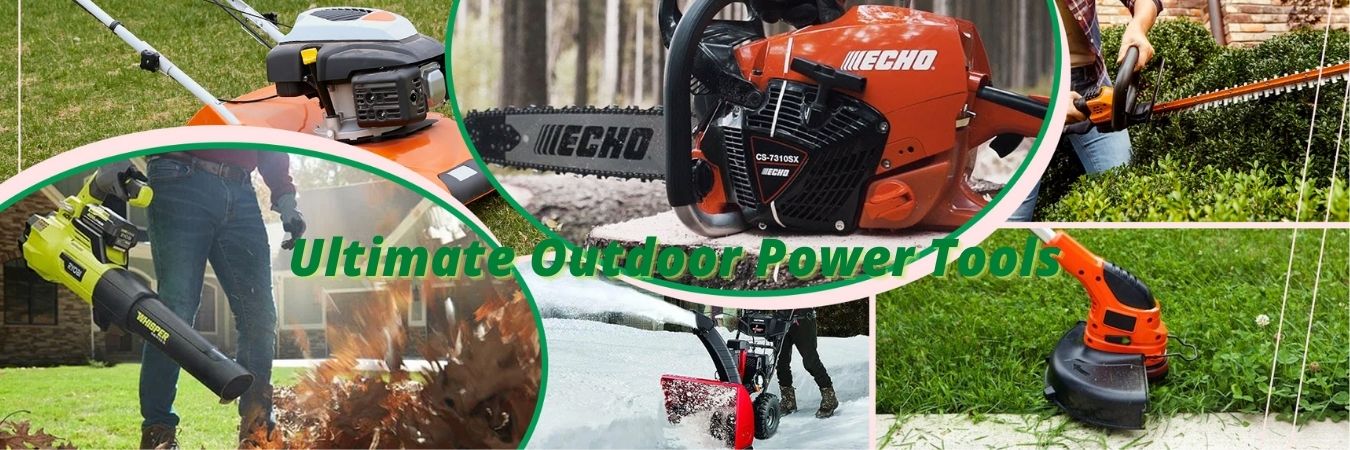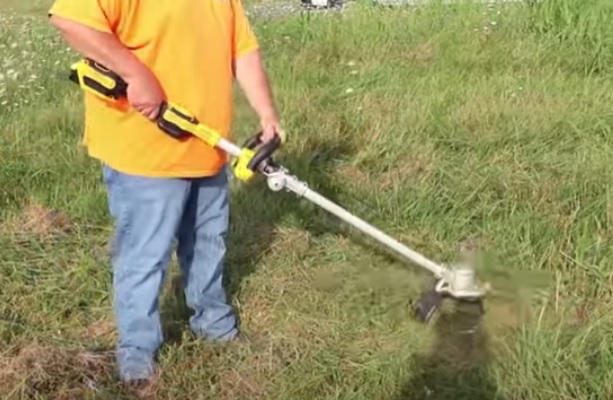We're an affiliate
We hope you love the products we recommend! Just so you know, we may collect a share of sales or other compensation from the links on this page. Thank you if you use our links, we really appreciate it!
A well-maintained lawn is a source of pride for many homeowners. To keep the grass and weeds under control, you’ll need a string trimmer, also known as a weed eater, weed wacker, or grass trimmer.
As a longtime homeowner and an avid gardener, I always took pride in maintaining a picture-perfect lawn. For years, I relied on my trusty gas-powered weed eater to keep my yard looking its best. It was a powerful machine that made quick work of the thickest weeds and overgrown grass. However, there were downsides, like the noise, the smell of gas, and the constant need for maintenance.
I began to notice that my neighbor’s lawn was always well-maintained, but without the noise and fumes that came with my gas-powered weed eater. Intrigued, I asked him about his lawn care routine, and he introduced me to his battery-powered weed eater. He raved about how lightweight, quiet, and easy to use it was, and I couldn’t help but feel envious.
After a bit of research and reading reviews about the best cordless string trimmers, I decided to take the plunge and purchase a battery-powered weed eater for myself. Once I got it home and started using it, I couldn’t believe the difference! It was so much lighter and easier to handle than my old gas model, and I no longer had to worry about mixing gas and oil or breathing in fumes. The quiet operation was a game-changer, allowing me to enjoy my time in the yard without disturbing my family or neighbors.
One concern I had when making the switch was whether the battery-powered weed eater would have enough power to tackle my yard’s needs. To my surprise, it had plenty of power to handle the grass and weeds I typically encountered, although it did struggle a bit with some thicker brush. The only other downside was the limited run time – I had to purchase an extra battery to ensure I could finish my lawn care tasks in one go.
Overall, I couldn’t be happier with my decision to switch from a gas-powered to a battery-powered weed eater. It’s made my lawn care routine more enjoyable, environmentally friendly, and easier on my body. While it may not be the perfect solution for everyone, it was definitely the right choice for me and my lawn care needs.
In this blog post, we will explore the pros and cons of battery-powered weed eaters, and compare them to other types like gas and corded models. By the end of this post, you’ll be able to choose the best cordless string trimmers for your lawn care needs.
The Different Types of Weed Eaters
Gas-Powered Weed Eaters
Gas-powered weed eaters use gas and oil to power the engine, making them more suitable for larger properties. Gas string trimmers are known for their cutting power and ability to handle thicker grass and weeds.
Electric Weed Eaters
Electric weed eaters come in two types: corded and cordless. Corded electric weed wackers require an extension cord to operate, while cordless electric models are powered by lithium-ion batteries.
Pros of Battery-Powered Weed Eaters
Lightweight and Easy to Handle
One of the biggest advantages of battery-powered string trimmers is that they are typically lighter and easier to handle compared to gas-powered models. This lightweight machine makes it easier to maneuver around your lawn, especially for those who may struggle with the weight of a gas trimmer.
Environmentally Friendly
Battery-powered weed eaters are better for the environment because they don’t require gas or oil. With no emissions or spills, they help reduce your carbon footprint.
Quiet Operation
Battery-powered weed eaters are quieter than gas-powered models. This makes them more pleasant to use and less disruptive to your neighbors.
Less Maintenance
Cordless weed eaters require less maintenance compared to gas-powered models. You won’t need to change the oil, spark plug, or clean the air filter, which saves you time and effort.
No Cords to Worry About
With a cordless string trimmer, you won’t need to worry about finding an extension cord or being limited by the cord’s length. This makes battery-powered weed eaters more convenient and easier to use in hard-to-reach areas.
Cons of Battery-Powered Weed Eaters
Limited Run Time
Battery-powered weed eaters typically have a limited run time of around an hour on a single charge, depending on the battery size. This may not be enough for larger yards, and you may need an extra battery or frequent recharging.
Less Power
Battery-powered models may not have the same cutting power as gas-powered string trimmers. For thicker grass and weeds, you might need a gas model to get the job done effectively.
Longer Charge Time
Battery-powered weed eaters may require a longer charge time compared to the time it takes to refill a gas tank. This can be inconvenient if you need to get your lawn care done quickly.
Higher Upfront Cost
Cordless weed eaters may have a higher upfront cost than gas or corded models, especially if you need to purchase extra batteries.
How to Choose the Best Battery-Powered Weed Eater
When looking for the best cordless string trimmers, consider the following factors:
- Battery Life: Look for a model with a longer run time, so you can complete your lawn care tasks without needing to recharge frequently.
- Weight: Choose a lightweight machine that is easy to maneuver around your yard.
- Power: Make sure the trimmer has enough power to handle the type of weed and grass in your yard.
- Attachments: Some battery-powered weed eaters can be transformed into other power tools, like a pole saw or hedge trimmer, by using attachments. This versatility can save you money and storage space.
- Adjustable Handle: An adjustable handle allows you to find the most comfortable position for you while using the trimmer, making it easier to handle for extended periods.
- Straight Shaft or Curved Shaft: Straight shaft weed eaters provide better reach and are more suitable for taller users, while curved shaft models are lighter and easier to maneuver. Choose the one that best fits your needs.
- Cutting Head: The cutting head should be easy to load with new string and provide efficient cutting performance.
- Warranty and Brand Reputation: Look for a reputable brand that offers a solid warranty and customer support.
Top Pick: The Best Cordless Weed Eater on the Market
Our top pick for the best battery-powered weed eater is the [Insert Brand and Model Name]. This cordless string trimmer offers a perfect balance of power, lightweight design, and ease of use. Its lithium-ion battery provides plenty of power for trimming grass and weeds in a typical yard, and it can last up to an hour on a single charge.
The [Insert Brand and Model Name] also comes with an adjustable handle and cutting head, making it comfortable and efficient to use. Plus, it’s compatible with various attachments, like a pole saw and hedge trimmer, increasing its versatility.
Conclusion: Battery-Powered Weed Eaters vs Gas and Corded Models
Battery-powered weed eaters offer several advantages over gas and corded models, including being lighter, easier to handle, and more environmentally friendly. However, they do have some disadvantages, such as limited run time and less power for tackling tough weeds.
Ultimately, the choice between a battery-powered, gas-powered, or corded weed eater comes down to your specific needs and preferences. If you have a smaller yard and want a quieter, more eco-friendly option, a battery-powered model might be your best choice. If you have a large yard or need extra power for tough weeds, a gas-powered model may be more suitable. And if you don’t mind dealing with an extension cord and want a more budget-friendly option, a corded electric weed eater could be the right fit.
Whatever type of weed eater you choose, make sure to keep safety in mind and follow the manufacturer’s instructions for use and maintenance. Happy weed whacking!
Frequently Asked Questions
How long do battery-powered weed eaters typically last on a single charge?
A: Battery life varies depending on the model and battery size, but most battery-powered weed eaters can last up to an hour on a single charge. For larger yards or longer trimming sessions, you may want to consider purchasing an extra battery.
Are battery-powered weed eaters suitable for large yards?
A: Battery-powered weed eaters can be used for large yards, but you may need to recharge the battery or have a spare battery on hand to complete the job. If you have a very large yard or require more power for thick grass and weeds, a gas-powered model may be a better option.
Can I use a battery-powered weed eater for commercial lawn care?
A: While battery-powered weed eaters are suitable for residential use, they may not be the best choice for commercial lawn care due to their limited run time and power. Professional landscapers often prefer gas-powered models for their durability and cutting power.
How do I maintain my battery-powered weed eater?
A: Battery-powered weed eaters require less maintenance than gas-powered models, but there are still some steps you should take to keep them in good working order. Regularly clean the trimmer head and cutting line, recharge the battery according to the manufacturer’s instructions, and store the trimmer and battery in a cool, dry place.
Are all batteries and chargers compatible with different battery-powered weed eaters?
A: No, not all batteries and chargers are compatible with different models or brands of battery-powered weed eaters. Always use the batteries and chargers recommended by the manufacturer to ensure proper function and avoid potential damage.
Can I convert my gas-powered weed eater to a battery-powered model?
A: Converting a gas-powered weed eater to a battery-powered model is not recommended, as they have different power sources and design requirements. If you’re interested in switching to a battery-powered weed eater, it’s best to purchase a new model specifically designed for battery power.


2 thoughts on “Pros and Cons of Battery Powered Weed Eaters”
Comments are closed.